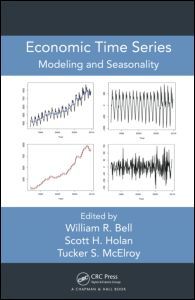Economic Time Series Modeling and Seasonality
Coordonnateurs : Bell William R., Holan Scott H., McElroy Tucker S.

Economic Time Series: Modeling and Seasonality is a focused resource on analysis of economic time series as pertains to modeling and seasonality, presenting cutting-edge research that would otherwise be scattered throughout diverse peer-reviewed journals. This compilation of 21 chapters showcases the cross-fertilization between the fields of time series modeling and seasonal adjustment, as is reflected both in the contents of the chapters and in their authorship, with contributors coming from academia and government statistical agencies.
For easier perusal and absorption, the contents have been grouped into seven topical sections:
- Section I deals with periodic modeling of time series, introducing, applying, and comparing various seasonally periodic models
- Section II examines the estimation of time series components when models for series are misspecified in some sense, and the broader implications this has for seasonal adjustment and business cycle estimation
- Section III examines the quantification of error in X-11 seasonal adjustments, with comparisons to error in model-based seasonal adjustments
- Section IV discusses some practical problems that arise in seasonal adjustment: developing asymmetric trend-cycle filters, dealing with both temporal and contemporaneous benchmark constraints, detecting trading-day effects in monthly and quarterly time series, and using diagnostics in conjunction with model-based seasonal adjustment
- Section V explores outlier detection and the modeling of time series containing extreme values, developing new procedures and extending previous work
- Section VI examines some alternative models and inference procedures for analysis of seasonal economic time series
- Section VII deals with aspects of modeling, estimation, and forecasting for nonseasonal economic time series
By presenting new methodological developments as well as pertinent empirical analyses and reviews of established methods, the book provides much that is stimulating and practically useful for the serious researcher and analyst of economic time series.
Periodic Modeling of Economic Time Series. Estimating Time Series Components with Misspecified Models. Quantifying Error in X-11 Seasonal Adjustments. Practical Problems in Seasonal Adjustment. Outlier Detection and Modeling Time Series with Extreme Values. Alternative Models for Seasonal and Other Time Series Components. Modeling and Estimation for Nonseasonal Economic Time Series.
William R. Bell, Ph.D., is the Senior Mathematical Statistician for Small Area Estimation at the U.S. Census Bureau. He is a recognized researcher in the area of modeling and adjustment of seasonal economic time series. He has also worked on development of related computer software, including software for RegARIMA modeling of seasonal economic time series (for the X-12-ARIMA seasonal adjustment program), and the REGCMPNT program for time series models with regression effects and ARIMA component errors.
Scott H. Holan, Ph.D., is an Associate Professor of Statistics at the University of Missouri. He is the author of over 30 articles on topics of time series, spatio-temporal methodology, Bayesian methods and hierarchical models. His work is largely motivated by problems in federal statistics, econometrics, ecology and environmental science.
Tucker S. McElroy, Ph.D., is a Principal Researcher for Time Series Analysis at the U.S. Census Bureau. His research is focused primarily upon developing novel methodology for time series problems, such as model selection and signal extraction. He has contributed to the model diagnostic and seasonal adjustment routines in the X-12-ARIMA seasonal adjustment program, and has taught seasonal adjustment to both domestic and international students.
Date de parution : 04-2012
Ouvrage de 496 p.
15.6x23.4 cm
Thème d’Economic Time Series :
Mots-clés :
K12089 Chapter; Seasonal Adjustment; seasonal; K12089 Part; adjustment; Seasonal Component; component; ARIMA Model; irregular; Seasonal ARIMA Model; airline; Irregular Component; model; Signal Extraction; Pseudo-true Value; hypothesis; Prediction Error Variance; bayesian; CDS Index; information; Seasonal Unit Root Test; Outlier Detection; Nonseasonal Component; Error Covariance; ARMA; MSE Percent; Economic Time Series; True DGP; LR Test Statistic; Homoskedastic Model; ARMA Model; Ra Te; GARCH Process; Np Np Np



